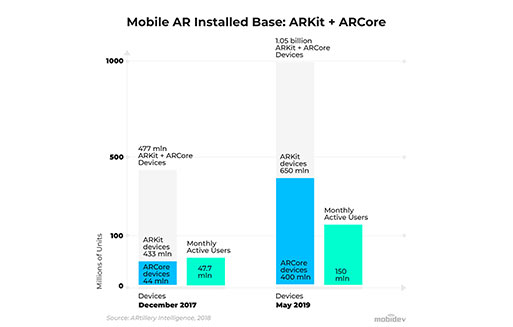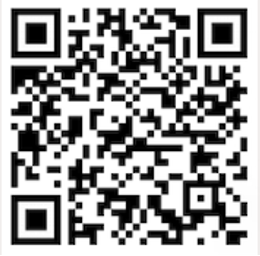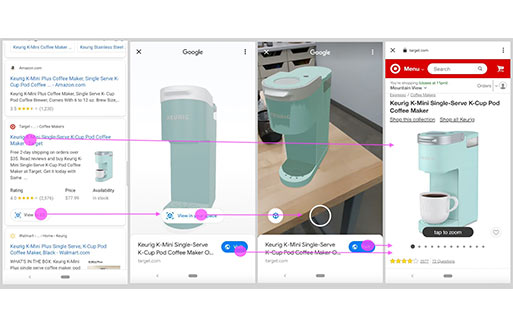

Augmented reality has led to the development of augmented reality applications, allowing users to experience products, visualize them, what they encounter when they buy, or experience a service.
AR maximizes computer-generated images according to reality, thus creating a unified look that strengthens the real world. AR applications range from interactive maps and virtual showrooms to multiplayer collisions. While more and more ARKit apps are available on Apple's iOS, ARCore on Android will be the future of AR.
Augmented reality is one of the most popular technologies of the last period. HubSpot has ranked the top 10 of the current mobile augmented reality applications. Since the release of Pokemon Go, there has been a 300% increase in the number of downloads of mobile augmented reality apps. Demand and investment in this technology has increased as the augmented reality has improved, costs have been reduced and application areas specific to the branches of business have been developed.
We've made a compilation of the best Augmented Reality apps you can find for iOS or Android phones.
While Google is closely interested in three-dimensional search results, Google offers the feature only on a certain animal basis, but will expand the scope of the vehicle in the near future to include objects and brands. Augmented Reality Agency Nsocial, you can view our Google augmented reality search results article that we have realized for various sectors with early moves and experience the services from related links.
It's also one of the biggest components of MOBILE AR: Mobile AR is app-less. This allows users not to download any ar application. Also mobile ar or browser base working webAR rescues brands to develop an ar app. Apple announced arkit 3.0, google’s arcore is rapidly growing its installed base.

A browser-based, no-application augmented reality experience. Until recently, Augmented Reality applications provided AR experience only through applications installed on mobile devices, however, this has changed with the widespread use of webAR technology as of 2019. webAR is a technical term used as a concept for all applications where Augmented Reality and Virtual Reality technologies work on web-based browsers. The Web XR concept, which used to advance through websites with Virtual Reality content, has expanded its scope with the increase of browser based Augmented Reality content. (Also the concept of XR is an abbreviation of the concept of Extended Reality. Augmented Reality (AR), Virtual Reality (VR), Mixed Reality (MR) technologies are included in the XR spectrum, but each of them is also called XR technologies.) First, it realized the webAR experience supported by the Safari browser at the same time in Mozilla. Very soon in Google Chrome, the ARCore infrastructure will begin to support Augmented Reality experiences over the Web. AR agency Nsocial has developed webAR technology. You can read our article on webAR and experience the sector-based experiences by printing out the image we placed in our article.
Please just scan the QR code below for webAR experience.

As ar agency Nsocial has just created a live traffic data on webAR. Now we use this function for aviation, railways and public transportation.
You can get more information about what is webAR live traffic data you can touch over it and read it. Below, we would like to share what ar agency Nsocial did for webar live data traffic.
Formula is easy: ecommerce + webAR + google augmented reality search results = enriched experimental marketing
All brands with e-commerce platform have added AR feature to both their mobile sites and mobile applications. Using the Augmented Reality technology, Brands aim to offer their customers a different value proposition that they cannot provide in their current online & offline shopping experience.
In Amazon, the world's largest online shopping and retail platform, it has started to offer thousands of products in hundreds of different categories to its customers in Augmented Reality (AR) mode. Now, not only for furniture, decoration, etc., but also all kinds of electronic goods, etc. that you can think of, can be displayed as Augmented Reality and then direct the user to purchase.
Apart from the products we buy only for use in our living spaces in furniture, etc., Augmented Reality has started to be used extensively in a different area such as the cosmetics industry. Many cosmetic giants such as Sephora, Loreal, etc., provide AR make-up applications and AR lenses published on platforms such as Snapchat / Facebook, allowing their customers to visually test their products with a single click without physically applying them to their faces. According to the faces of the make-up products as if they were really applied, the customers can decide and purchase very quickly and effortlessly. It is not at all difficult to say that there is a significant improvement and comfort for women users who had to go to physical stores and try makeup products before.
The furniture industry is undoubtedly one of the first and most effective areas of Augmented Reality. Regardless of whether the customer examines the product in detail and likes it, it never reaches the real result without trying it in his own place, whether the priorities are in online shopping or in-store purchases. For example, I guess we all experienced situations where we found that a seat you liked and bought in the store or on the internet, whether you fit it in your home or office, even if you have made very fine measurements.
In the same way, even if you have met the dimensions, we have experienced at least once that the furniture you bought this time is incompatible with your existing furniture and colors and patterns, and that it does not look like you ever dreamed. Here, Augmented Reality applications eliminate this problem. As with all AR-supported furniture applications, you can position the product you like in 3-D as if it is there in the real place you are in, you can easily try out different color and pattern options, and make a decision by comparing the physical dimensions.
Here is the flow of how google augmented reality search results work.

Instore shopping augmented reality integration is the newest digital transformation of retail shopping.
100 million users were expected to utilize AR-enabled shopping technologies by 2020 in retail.
Several companies have gotten out in front of consumer demand for AR shopping. American Apparel, Uniqlo and Lacoste have deployed showrooms and fitting rooms that provide try-before-you-buy options in augmented reality spaces. Smart mirror technologies that scan RFID tags also offer the ability to bring recommendations to the brick-and-mortar shopping experience. IKEA customers have access to an app that permits them to point their phones at spaces and see what different products would look like in their own homes.
48% of consumers said that they’d be more likely to buy from a retailer that provided AR experiences. Unfortunately, only 15% of retailers currently put AR to use. Only a further 32% of retailers stated they plan to deploy virtual or augmented reality applications over the next three years.
Makeup, fashion and lifestyle brands all stand to gain significant appeal with customers by using technologies that handle facial recognition, adapt to local lighting conditions and provide personalized advice. Virtual assistants will also significantly change the shopping experience.
As AR company Nsocial, we developed mirrar, it's augmented reality supported mirror. You can try on the clothes without going to cabin and allows you an unforgettable brand and shopping experience.
You can find more details about our mirrar tool on our related article.
One of the areas where Augmented Reality applications are used the most is Industry and Business (Enterpirse) market. The release of Microsoft HoloLens in 2016 has helped many companies implement AR applications, especially in manufacturing facilities and factories. Even though Vuzix etc. smart glasses manufacturers produce AR glasses that can be used in the field before Microsoft HoloLens, it would not be wrong to say that it was Microsoft that shaped the market. AR use in industry can be applied in many different ways. The most common of these are remote AR support systems that are provided to employees through smart glasses and / or mobile devices. In Augmented Reality applications in this category, the staff on duty can be an example of repairing information about the operation or repair of any machine by means of visual instructions from another well-equipped staff on the subject in a different location. As remotely connected personnel can see what other personnel in the field of physical repair live, they can add instant visual signs on the images, so that they can instantly get information on how to repair the personnel in the field.
In addition, the other Augmented Reality application, which has been widely used in the industry, is showing the data of the machines momentarily in AR mode. In this method, instant data (example: energy consumption, pressure, efficiency, production capacity, etc.) received from IoT services to which the machines are connected are displayed to the technical team with the help of Augmented Reality-supported smart glasses and / or mobile applications, thus, it is very large for the related technical teams. working facilities are provided. We can say that the use of Augmented Reality in the field of industry will increase its use all over the world as part of Digital Transformation by more businesses in the coming years.
With the help of these applications, which are used extensively in the field studies as Augmented Reality support systems, employees with low technical equipment can easily get help from people who are connected remotely and who are superior in terms of knowledge / experience, and significant time savings are achieved in solving the problem. Apart from the live support system, thanks to the instructions that can be assigned to the relevant maintenance systems before, the related technicians and / or engineers can apply how to repair the machines much more easily with the Augmented Reality usage instructions, not through the written manuals.